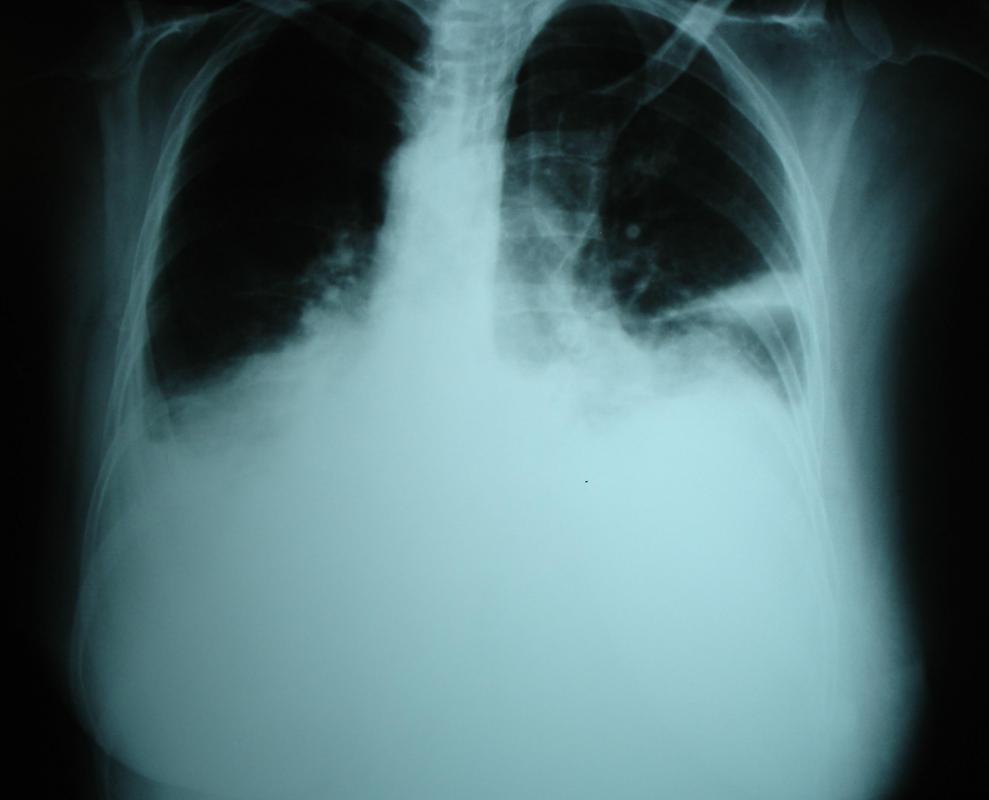At WiseGEEK, we're committed to delivering accurate, trustworthy information. Our expert-authored content is rigorously fact-checked and sourced from credible authorities. Discover how we uphold the highest standards in providing you with reliable knowledge.
What is Chylothorax?
Chylothorax is a medical condition in which a fluid known as chyle accumulates in the cavity which surrounds the lungs, making it difficult for the lungs to inflate. As a result, the owner of the lungs experiences difficulty breathing, which results in reduced oxygenation of the blood and a cascading series of medical complications which can lead to death in severe cases.
Patients can develop this condition in response to thoracic trauma, including trauma caused by surgery, and the condition can also develop as a complication of lymphoma. Premature babies can also develop this condition, and in some families, there is a history of congenital chylothorax which may lead a doctor to recommend special measures during labor and delivery to protect newborns.

This condition is a type of pleural effusion, meaning that it is a medical condition characterized by a buildup of fluid (effusion) in the pleural space, the cavity which surrounds the lungs. The pleural space normally has some fluid present to lubricate the lungs and facilitate breathing. In pleural effusion, fluids such as blood or chyle fill up the pleural cavity, inhibiting lung function.

Chyle primarily contains lymph, mixed with some fatty acids which give it a milky color. It is a byproduct of digestion which normally drains away through lymph ducts in the chest. When these ducts become blocked, the fluid can spill over into the pleural cavity, leading to chylothorax.
Patients with the condition usually experience severe difficulty breathing, and their lungs may even collapse from the fluid buildup. Medical imaging studies such as X-rays and MRIs can reveal a fluid buildup, and biopsies can be used to determine which type of fluid is present. In some cases, chylothorax can resolve itself, but it may be necessary to insert a tube to allow the fluid to drain, and then to address the cause of the buildup of chyle so that the pleural effusion will not happen again.

The risk factors are well known, and people who have these risk factors will be monitored closely for the sounds of fluid buildup. For example, people who experience trauma to the chest will be evaluated in their medical workup to look for signs of chyle around the lungs, and patients are routinely monitored after surgery for the signs of any complications, including chylothorax. People with lymphoma will also be examined for the signs of complications when they receive treatment and care.
AS FEATURED ON:
AS FEATURED ON:


















Discussion Comments
My beautiful 4 1/2 year old Rottweiler died suddenly from chylothorax. There was no chest trauma or tumor. We rushed her to the Vet because she was having difficulty breathing, never thinking she would not come home. So difficult to accept. The X rays showed fluid in the lung cavity and around the heart. The tried draining the fluid but it was too far gone.
Our 4 year old gentle giant female Rottie passed away on Saturday from chyothorax. She had trouble breathing during the night and again on Saturday afternoon and started to vomit a yellow thick fluid. We rushed her to the vet, but it was too late. X rays showed her lungs and heart were already filled up. She had no chest trauma or surgery. She just had a physical a couple of months ago. There is no indication until its too late.
If there is an issue with Clylothorax after a infant's heart defect repair, could this be the operating surgeon's mistake or is this just a common condition from trauma during surgery?
@Emilski - I actually just got back from having a cat with chylothorax. I noticed one day that my cat seemed to be coughing a lot. I thought at first maybe it was just a hairball or something, but then he acted like he was having trouble breathing. I took him to the vet and they decided that he had chylothorax.
Apparently chylothorax can happen in dogs and cats or any other mammal, but the causes aren't always clear. The vet told me that sometimes it is caused by a tumor, but that wasn't the case here. The process of the overflowing thoracic ducts is the same, though.
The vets drained the fluid, and kept him for a few days for monitoring, and now he seems to be okay. He didn't fall or do anything to hurt himself that I know of, so I don't know what could have caused it.
@JimmyT - I was wondering the same thing, and looked up some more information. I couldn't really find any good information about why the duct would become blocked. I did find some articles that talked about how damage to the thoracic duct could cause it to tear in which case the lymph and fatty acids would just leak out into the pleural cavity.
Something I was thinking was that maybe trauma to the chest could bruise the duct or cause it to swell somehow. I would expect that something like that might cause a blockage. Maybe someone with more knowledge can help us out.
When I was reading, I saw a few pages with information about chylothorax in cats. Has anyone ever heard of this? Is it caused by the same things, and how common is it?
The article says that chylothorax is caused by chyle that overflows in the chest when the lymph ducts are blocked, but what exactly causes them to be blocked in the first place? Is there a physical obstruction, or is there just so much lymph that it can't all be processed fast enough?
I know lymph is mostly white blood cells that carry away bacteria and other pathogens from our body. Is the increase in lymph usually a result of some other underlying problem like an infection?
I had heard of conditions where someone's lungs could start to fill with fluid, but I didn't know a condition existed where the fluid formed around the outside of the lungs.
When chylothorax begins, how long does it usually take for the chest cavity to fill up to the point where serious issues occur? The article mentions people being monitored after surgery or during lymphoma checkups, it sounds like sometimes it could take quite a while until problems arise. Is that right?
Are there any times when chylothorax is present when there hasn't been one of the usual indicators like a chest trauma or surgery?
Post your comments